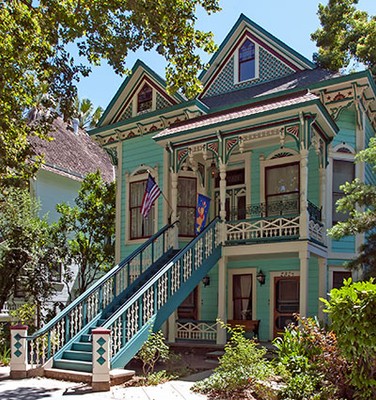The Herman Winters House
Introduction
Text-to-speech Audio
Completed in 1890, this home was built for Herman Winters, a German merchant who arrived in Sacramento during the 1849 Gold Rush. Located among a row of late 19th-century homes that were built on what was once a Gold Rush-era campgrounds, the home was designed in the Queen Anne-Eastlake architectural style. The Herman Winters House is one of the largest and most ornate homes of its kind still standing in Sacramento. Notable for its architectural design, quality materials, and craftsmanship, the property was added to the National Register of Historic Places in 1998.
Images
The Herman Winters House, Sacramento

Backstory and Context
Text-to-speech Audio
The Herman Winters House is a three-story, Queen Anne-Eastlake house built in 1890 for Herman Winters, a German merchant in Sacramento. The city of Sacramento developed following the 1849 discovery of gold in the Sierra Nevada foothills. As Sacramento became a point of departure for the gold fields, its population soared, with miners and entrepreneurs erecting temporary and permanent dwellings amidst the ensuing gold rush. In the years and decades that followed, merchants such as Winters were able to profit from the city’s rapid growth by providing goods to an expanding population.
A newspaper article published in The Sacramento Bee in the summer of 1891 described the Herman Winters House as “a typical Sacramento cottage,” refined with decorative elements. At the time, the home was built on the eastern outskirts of the city, in an area which was then known as the Gypsy campgrounds. The newspaper article speculated that this area would soon be filled with permanent homes. As anticipated, the area did continue to develop, with the construction many other homes (on what is now H Street) reflecting a mixture of Queen Anne, Italianate, and Gambrel-style houses.
The Queen Anne-Eastlake architectural style developed from the interior design and furniture design styles that were popularized during the 19th century by Charles Eastlake, who wrote a book in 1868 titled Hints on Household Taste, Furniture, Upholstery, and Other Details. The Eastlake architectural style is characterized by the decorative use of carved wood, turned on a lathe or cut with a jigsaw, with a preference for angular and notched shapes, rather than curves. When the Herman Winters House was added to the National Register of Historic Places in 1998, the nomination form described the home as “a showcase,” as its ornate elements displayed Winters’ wealth and status within the community.
Some vernacular architectural structures that were once present in this east Sacramento neighborhood have been lost, as the Winters’ home previously contained a shed that was used to house a milk cow and some chickens. However, narrow yards are still visible on either side of the house. A Sycamore tree was originally planted in front, near the sidewalk. Along with other historic homes from the period, the Herman Winters House was included in a 1973 book, Vanishing Victorians: A Guide to the Historic Homes of Sacramento. The book described the intricately carved wooden doors of the home and its overall ambiance:
“In the evening, the light from the hall shine through an intricate pattern of frosted and cut-glass window panels. Two ornate colored glass windows are like jewels in the crown of this stately structure. The delicate spindlework of the upper porch is repeated in the lower porch. Wooden fans and stars form a frieze below the cornice, and dentils under the eaves run the length of the gables.”
Sources
"Eastlake (1868-1890)", Noe Hill. Accessed September 1st, 2023. https://noehill.com/architects/style_eastlake.aspx.
"National Register #98001634: Winters House", Noe Hill. Accessed September 1st, 2023. https://noehill.com/sacramento/nat1998001634.asp.
"Winters House: Nomination Form, National Register of Historic Places", National Archives. October 13th, 1998. Accessed September 1st, 2023. https://catalog.archives.gov/id/123860698.
Noe Hill
